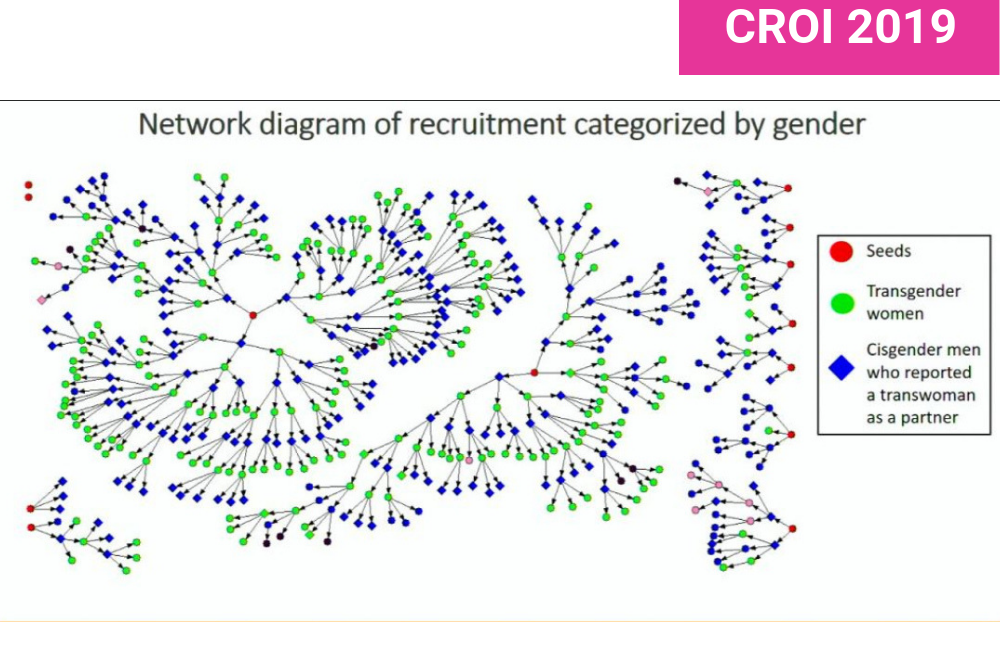
A study from Peru’s capital, Lima, has found that the sexual partners of transgender women there are largely heterosexual, cisgender men who rarely have sex with other men. The study was presented at the recent Conference on Retroviruses and Opportunistic Infections (CROI 2019) by Dr Jessica Long of the University of Washington in Seattle.
Transgender women worldwide generally have rates of HIV even higher than gay and bisexual men, and Peru is no exception. HIV prevalence in gay men is currently about 12-18% but prevalence in transgender women is 30%. Yet prevalence in the heterosexual male population is less than 0.4%. Figures like this have led epidemiologists to conclude that transgender women must be getting their HIV from men who have sex with other men.
However, a study from San Francisco presented at the 2017 IAS conference in Paris challenged this view. It used phylogenetic analysis to retrospectively re-classify the male partners of trans women as heterosexual, unless their HIV was also linked genetically to other men via sexual contact. It found that 47% of transgender women were in a ‘cluster’ or linked group of infections along with at least one heterosexual man (ruling out men who injected drugs) but only 16% in a cluster with a gay or bisexual men.
It suggested that the sexual partners of transgender women form a separate and distinct risk group. It also found that a lot of transgender women were in clusters with each other, suggesting that trans women’s high HIV rates may partly be due to their belonging to a small, relatively isolated, and tightly networked community.
This study
The study from Lima also found that the partners of transgender women form a distinct group, in general, from gay and bisexual men. There was a minority of men who have sex with men among the trans women’s sexual partners, but they had different characteristics from their other partners.
Participants were recruited through respondent-driven sampling. This involves engaging ‘seeds’ who are volunteers who then recruit their social contacts to the study.
However, as Dr Long commented, “The partners of transgender women do not form a social network.” Her team therefore asked transgender female “seeds” to recruit their sexual partners into the study, who were then asked to recruit their sexual partners. Eleven seeds recruited partners and formed clusters ranging in size from four to 250 people. The longest 'chain' was eleven people long, i.e. the last person in the chain was ten sexual links away from the seed.
A diagram of the people recruited for the study shows very clearly that most of the transgender seeds recruited a ‘first wave’ of cisgender men who in turn recruited a second wave of transgender women, who then recruited a third wave of cisgender men. (See above for the diagram, where transgender women are the green circles and cisgender men blue diamonds.) However, a few of the cisgender men are also linked to other men, indicating male/male sex.
The eleven seeds recruited 27 partners, 25 cisgender men, one cis woman and one trans woman. This 'first generation' then recruited another 45 partners, of whom 11 were cisgender men, two cisgender women, and 32 transgender women.
Of the 203 partners of trans women, 97% were cis men. Only two partners were cis women and five were trans women. These partners reported that their own recent sexual partners were trans women (100%), cis women (55%) and cis men (7%).
In other words, there was a remarkable degree of segregation between the groups. This questions the hypothesis of the US study that there might be a lot of direct sexual transmission happening between trans women, or between the male partners of trans women and other cis men. It's important though to remember that two different cities and cultures are involved here.
Participants’ reports of who they were sexually attracted to closely resembled the people they reported having sex with. In particular, 83% of the partners of trans women reported they were attracted to trans women and 68% to cisgender women. But only 8.9% reported being attracted to cisgender men.
The minority of men who had sex with men were very different from the other partners of trans women. They were nine times more likely to identify as homosexual and nearly five times as likely to know their HIV status as the other partners.
While the proportion of partners of trans women who knew they had HIV was lower, at 3.5%, than it was among men who had sex with men (11.6%), or among trans women (5.6%), this is still ten times higher than prevalence in the general male population in Peru. In addition, only 46% knew their HIV status compared with 58% of transgender women and 78% of men who have sex with men, so some could have HIV but not know it.
One finding was that transgender women and their partners had a lot of transactional sex (for money, food, gifts or shelter) – but it was not always the women who were the 'sex workers' and the men who were the 'clients'. Ninety per cent of transgender women reported selling sex but so did 56% of their partners; 78% of the partners reported buying sex but so did 57% of the trans women. The minority of gay and bisexual men also often sold sex, but almost never bought it.
Dr Long commented that although the survey did not find a complete explanation of why HIV rates were higher in transgender women in general, it did find that their partners were separate from gay men and a risk group in themselves.
Long JE el al. Little or no overlap of sexual networks of transgender women and MSM in Lima, Peru. Conference on Retroviruses and Opportunistic Infections, Seattle, abstract 841, 2019.
View the abstract on the conference website.
Watch the webcast of this presentation on the conference website.
